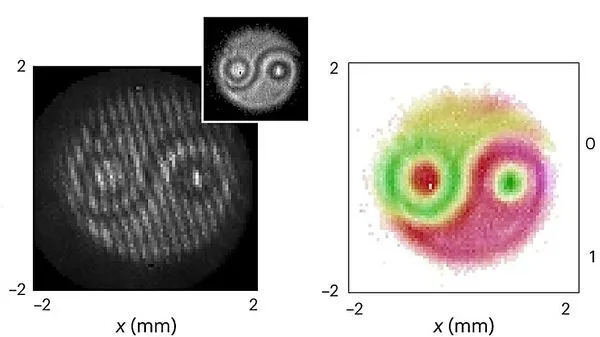- cross-posted to:
- [email protected]
- cross-posted to:
- [email protected]
Quantum ‘yin-yang’ shows two photons being entangled in real-time::The stunning experiment, which reconstructs the properties of entangled photons from a 2D interference pattern, could be used to design faster quantum computers.



This is also the basics of quantum communications.
deleted by creator
No spooky action at a distance
deleted by creator
deleted by creator
I don’t think there’s really any “changing” going on. The state of both entangled particles are unknown until one is measured, but I highly doubt that the act of measuring one suddenly determines the other’s state. They were already in those states, but before measurement it was an unknown variable which could be treated as a superposition. Once one is measured, then you know the state of the other entangled particle. Not because the act of measuring one affects the other (see: spooky action), but simply because the nature of entangled particles means the other would have to have to be the opposite of what you measured.
There’s no remote interaction, it’s simply mutual information
At least, that’s my take
Edit: this is why we can’t use entanglement for FTL communication. It just doesn’t work like that
Edit 2: seems my understanding was way off, but I’m leaving this comment up for the sake of context for the replies… Thanks to the people that responded for trying to clear things up. Quantum physics is weird.
Ah yeah kinda, The two particles would be in a super position state. Meaning that there could be a number of possible states and each state has a certain probability.
The reason quantum entanglement is so weird, Is that by measuring one Particle changes the state of the other particle, it is in fact spooky action at a distance. How these particles communicate with each other is unknown but we cannot use it as a communication method because the act of measuring one of the particles destroys the entanglement. The states of the particles are random before we measure it. There is no state at which both particles agree upon before they’re separated.
When the two particles are entangled, no “information” is communicated. So we can think of it as The particles exchanging random information that has no use to anything. This solves the faster than light communication problem because no real information is sent, Only random data. They’re experiments that try to test this hypothesis called the quantum eraser.
This is a common misunderstanding due to trying to think of things classically. I’d recommend “the road to reality” by Penrose if you want a better understanding.
Also it is not why we cannot use entanglement for FTL info, but you’ll understand that more once you understand entanglement better.
Just started reading this and it feels WAAAY over my head but I’m going to take author’s word for it that I will glean something from it.
Meh, it’s a losing battle try to establish what’s actually going on mechanically. It’s best to just stick to the rules we can prove and leave the underlying “how” as an implementation detail.
What we know is that it is possible for distant particles to become entangled without respect for relativistic limits. There’s effectively no difference between saying that the entanglement propagates regardless of distance (simultaneously FTL) or that the entanglement propagates regardless of time (sub-FTL regardless of simultaneity).
The issue is that an observer must at some point have observed both particles to know that they’ve become entangled. This is already a problem at any scale, but it gets much worse at relativistic distances because you can no longer even be certain when the two tangles are entangled, including and up to whether or not the particle you are locally observing is currently entangled. You’re stuck playing relativistic Two Generals’ Problem in such a way that if there was an FTL transmission, any useful information from it is rendered inaccessible without first receiving additional sub-FTL information.
This is the fundamentally frustrating thing about quantum mechanics. As far as we currently understand physics, any experiment which would reveal the actual underlying physical nature of the quantum world would itself be physically impossible (e.g.: FTL travel, time travel, violating the uncertainty principle).
Not really. In order to find the wave function you need to measure both particles and compare both sets of superposition info to know that the particles were entangled. The information sharing between Alice and Bob would still have to be through standard means.